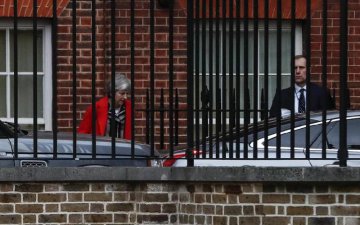
A "Disorderly Brexit" could cost Britain 8 percentage points of potential GDP growth over the next five years, the Bank of England (BoE) said in a report released on Wednesday.
The BoE said the loss of 8 percentage points in potential GDP growth between November this year and the end of 2023 could occur in what it found to be the worst-case scenario for Brexit when the exit process formally ends but without any deal on trade or tariffs.
Under this worst-case scenario, dubbed a Disorderly Brexit by the BoE in its EU Withdrawal Report, there would be no deal between Britain and the 27 remaining nations in the EU bloc, and both the EU and Britain would impose tariffs on goods and services,
"The reduction in openness will act to reduce the UK economy's productive capacity and in most scenarios its rate of growth in the short term. Leaving the EU abruptly, without a withdrawal agreement and implementation period would amplify these effects," The BoE report noted.
A Disorderly Brexit would also mean that Britain's profitable financial sector would trade with the EU under the World Trade Organization (WTO) rules, raising barriers and costs.
In addition, Britain's trade under this Disorderly Brexit would suffer a serious blow outside the EU, with Britain losing any of the benefits of trade treaties negotiated until now by the EU, which it currently enjoys.
The BoE report said: "Brexit is unique. Large negative supply shocks are relatively rare, and there is no precedent of an advanced economy withdrawing from a trade agreement as deep and complex as the EU."
The strong negative effects of the Disorderly Brexit would see a sharp rise in unemployment, and an increase in Consumer Price Index (CPI) inflation to 6.5 percent (CPI October rate is 2.4 percent).
House prices would fall 30 percent, and commercial property prices by 48 percent, while there would be an outflow of workers from the British economy, with a subsequent problem for employers of a mismatch between jobs open and skilled workers to fill the posts.
The BoE stressed this was the worst-case scenario and provided a series of less gloomy possible outcomes.
Under the BoE's model of a Disruptive Brexit, which would see tariffs and other barriers between Britain and the EU suddenly introduced, Britain would retain the benefit of the EU's trade deals negotiated up to now and would recognise EU product standards, however the EU would not reciprocate for British goods.
Under the "Disruptive Brexit", GDP would lose 3 percent of its potential growth over the next five years, joblessness would again rise sharply but to 5.75 percent and CPI inflation would peak at 4.25 percent.
The BoE also modelled Brexit scenarios based on the agreement between the British government and the EU, with two separate levels of a deal labelled as Close Deal and Less Close Deal.
The best outcome modelled was for Britain to "retain a Close Economic Partnership with the EU", which would see comprehensive arrangements for free trade in goods and some trade in business and financial services.
Under the Close Deal scenario, GDP growth would gain 1.75 percentage points over its current path, with both inflation and unemployment falling below their current projected levels for most of the five years up to the end of 2023.
The BoE modelled with its Less Close Deal scenario a loss of 0.75 percentage points to GDP growth with marginal rises in both jobless rates and inflation rates.
The BoE drew up its EU Withdrawal report at the request of British Parliament's House of Commons Treasury Committee, and the report will be delivered to committee members on Thursday and will be available to inform Members of Parliament (MPs) in their vote on British Prime Minister Theresa May's Brexit agreement with the EU, which is scheduled for December 11.























Latest comments